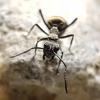Is this wasmannia / little fire ant?
I got this 3 or 4 months ago.
The other colony color is darker than this one.






Is this wasmannia / little fire ant?
I got this 3 or 4 months ago.
The other colony color is darker than this one.





Tetramorium sp, possibly tetramorium caldarium.
I need to put work on my skill to identify ants. All the ants look same for me ![]()
![]()
![]()
Yeah this is a Tetramorium species, probably something native because southeast Asia has a lot of Tetramorium species which are closely related and look like this. The propodeal spines are too long for caldarium or simillimum. I think there is a good chance that it's one of the species that used to be in the genus Triglyphothrix before it was synonymized with Tetramorium, so maybe T. lanuginosum or something similar.
Yeah this is a Tetramorium species, probably something native because southeast Asia has a lot of Tetramorium species which are closely related and look like this. The propodeal spines are too long for caldarium or simillimum. I think there is a good chance that it's one of the species that used to be in the genus Triglyphothrix before it was synonymized with Tetramorium, so maybe T. lanuginosum or something similar.
I'm on antwiki right now. They all look almost the same. Not much color differences. I think we need proper equipment to ID Tetramorium?
Yeah this is a Tetramorium species, probably something native because southeast Asia has a lot of Tetramorium species which are closely related and look like this. The propodeal spines are too long for caldarium or simillimum. I think there is a good chance that it's one of the species that used to be in the genus Triglyphothrix before it was synonymized with Tetramorium, so maybe T. lanuginosum or something similar.
I'm on antwiki right now. They all look almost the same. Not much color differences. I think we need proper equipment to ID Tetramorium?
Not really. there's slight anatomical differences, should be listed under the identification section. Like spine length and curvature, hair density, tarsal claws, tibial spurs, etc.
If you look on the back section of the mesosoma (called the propodeum), the propodeal spines on your ants are very long and noticeable. Compare it with species like Tetramorium caldarium or T. simillimum and those species have very short spines that look like mere nubs. Upon looking through AntWeb at Indonesia's Tetramorium, some possibilities for yours include (in my opinion) T. adpressum, T. kraepelini, and T. lanuginosum, but there is no guarantee that your species is a species that is officially recorded from Indonesia or even a species that is described or imaged. Honestly I'd say lanuginosum is a pretty fair bet, as they are the most frequently encountered/collected among their group of species. In your pictures I think the dense hairs characteristic of lanuginosum can be seen on the queen.
0 members, 1 guests, 0 anonymous users